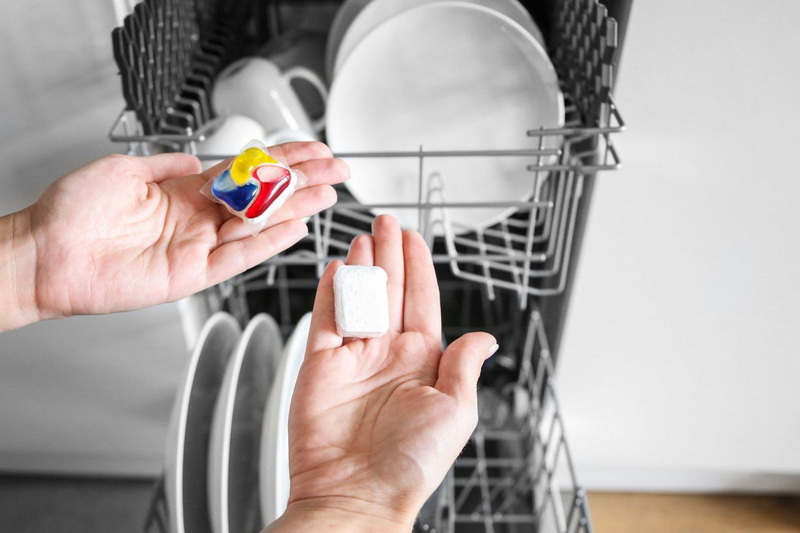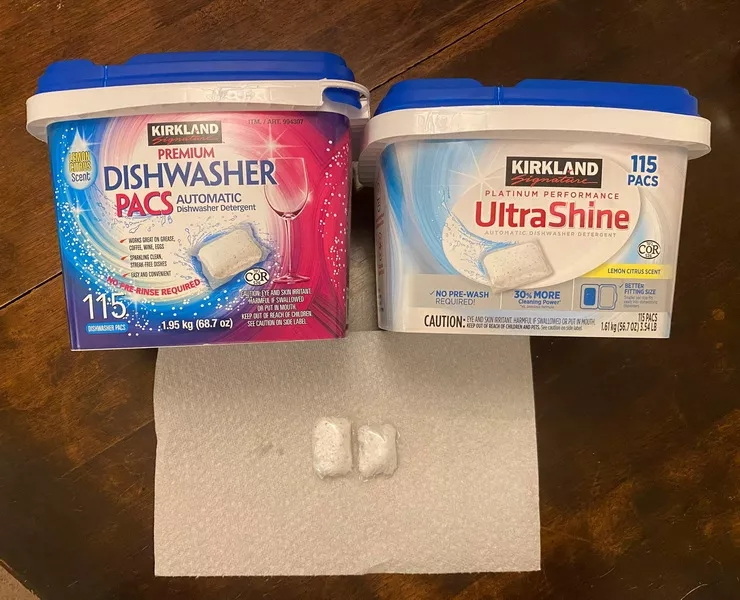Dongguan UFine Daily Chemical Co.,Ltd.
- All
- Product Name
- Product Keyword
- Product Model
- Product Summary
- Product Description
- Multi Field Search
Views: 222 Author: Tomorrow Publish Time: 11-07-2025 Origin: Site











Content Menu
● What are dishwasher detergent pods?
● How pods work in the dishwasher cycle
● Potential drawbacks and considerations
● Choosing the right pod for your dishwasher
● Detergent pod customization and OEM/ODM considerations
● Environmental and health considerations
● Loading, dosing, and maintenance tips
● Comparing pod formats to alternatives
● Environmental and safety case studies
● FAQ
>> 1. Do dishwasher pods work in all water temperatures?
>> 2. Can dishwasher pods leave residue on dishes?
>> 3. Are dishwasher pods safer for children than liquids or powders?
>> 4. How should I store dishwasher pods?
>> 5. Are there environmentally friendly pod options?
Automatic dishwasher detergent pods have become a common choice for households seeking convenience and reliable cleaning performance. This article examines what pods are, how they work, their benefits and potential drawbacks, and how to choose the right product for different dishwasher types and water conditions. We will also address common myths and provide practical usage guidance to help you maximize results while maintaining appliance longevity.

Dishwasher detergent pods are pre-measured, dissolvable packets containing concentrated cleaning agents designed to be placed in the dishwasher's main detergent compartment or directly in the wash chamber, depending on the brand and model. Each pod typically includes a combination of:
- Surfactants to break down grease and oils
- Builders or enzymes to enhance cleaning efficiency
- Rinse aids or additives to improve drying and prevent water spots
- Stabilizers and sometimes fragrances or brighteners
The pod is designed to dissolve at the right stage of the wash cycle, releasing cleaning agents when needed and reducing the risk of over- or under-dosing. Pods come in various formulations, including concentrated phosphate-free options, enzyme-enhanced blends, and specialty formulas aimed at glassware care, rust prevention, or baby-safe environments.
Dishwasher cycles use multiple stages, including pre-wash, main wash, and rinse. Pods are engineered to release their contents gradually or upon exposure to water pressure and the appropriate temperature. This process typically unfolds as follows:
- The dishwasher fills with water and begins the pre-wash or wash phase.
- The pod enters the wash chamber and begins to dissolve, releasing cleaning agents.
- Detergents mix with water to create a cleaning solution that penetrates soils on dishes.
- Rinse cycles remove remaining soil and detergent residues, aided by rinse aids if present.
- The final rinse uses hot water to promote drying and minimize water spots.
Manufacturers design pods to respond to water temperature and flow, ensuring that the detergent is active during the main wash while minimizing residues on delicate items. Some pods include internal layers that dissolve sequentially, providing a staged release of cleaning agents to tackle stubborn soils first and then protect during the rinse phase.
- Convenience: Pre-measured doses reduce the guesswork of measuring liquid or powder detergents, leading to fewer dosage errors.
- Consistency: Each cycle uses a standardized amount of cleaning agents, which can improve repeatable results.
- Space-saving: Pods are compact and reduce packaging clutter compared to bulk detergents.
- Reduced mess: No measuring cups or powders to spill.
- Improved dosing accuracy: Helps prevent excess chemical use or residue on dishes.
In addition to these core benefits, pods often offer compatibility with specific dishwasher features such as sensitive cycles, extra-dry options, and glassware care programs. Some pod formulations are optimized to work with high-efficiency (HE) machines, delivering effective cleaning with lower water usage.
- Cost: Pods can be more expensive per load than some liquid or powder detergents.
- Sensitivity to water hardness: Some formulations perform better in hard water; others may leave residues in soft water.
- Dishwasher compatibility: A few models have specific recommendations; always check the user manual for compatible detergent formats.
- Residue concerns: If a pod fails to fully dissolve, it can leave a film on dishes or inside the dishwasher.
- Environmental impact: Packaging and the materials used in pods vary by brand; consider recyclable packaging and eco-friendly formulations.
- Storage and handling: Pods can be slippery when wet and should be kept in a dry place to prevent premature dissolution.
To select an appropriate pod, consider several factors:
- Water hardness: Hard water can be challenging for detergents; look for formulations with built-in water-softening agents or consider pairing with a separate water softener if your area has very hard water.
- Soil level: Heavily soiled dishes may benefit from multi-component pods with stronger enzymes or boosters designed for tough stains like dried pasta sauce, coffee, and grease.
- Temperature ranges: Some pods are optimized for high-temperature cycles; verify performance at your typical wash temperatures. For cold pre-rinse settings, ensure the pod remains effective when initial contact occurs.
- Drying performance: If your dishwasher struggles with drying, you may want pods that include rinse aids or are paired with a dedicated rinse-aid product. This pairing can help reduce water spots and improve overall dryness.
- Glassware care: For households with a lot of glassware, choose pods formulated to prevent etching or cloudiness and that include gentle cleaners.
- Brand and certifications: Look for reputable brands with third-party testing, safety certifications, and transparent ingredient lists. Certifications from environmental or consumer-safety groups can provide additional assurance.

- Keep pods out of reach of children and pets; store in a cool, dry place away from moisture.
- Do not mishandle or puncture pods, as the contents can be concentrated and irritants if exposed to skin or eyes.
- Follow the manufacturer's storage instructions to maintain pod integrity and performance.
- Avoid storing pods in direct sunlight or in humid environments to prevent premature dissolution.
For overseas manufacturers and contract packaging, some suppliers offer OEM/ODM services for detergent pods. This can include:
- Custom fragrance, color, or scent-free options
- Tailored enzyme blends for particular soil types
- Targeted packaging solutions and label compliance for different regulatory regions
- Private-label branding and certification documentation
If you are sourcing pods for international markets, verify regulatory compliance, such as safety data sheets, ingredient transparency, and packaging labeling requirements in the destination country.
- Biodegradable formulations: Some pods use biodegradable surfactants and reduced packaging to minimize environmental impact.
- Phosphate-free options: Many regions regulate or ban phosphates; select phosphate-free pods to comply with local environmental guidelines.
- Fragrance-free options: For sensitive individuals or households, fragrance-free pods can reduce exposure to potential irritants.
- Recycling and packaging: Prefer brands with recyclable packaging and minimal plastic use.
- Ingredient transparency: Seek brands that publish ingredient lists and potential allergen information to help consumers make informed choices.
- Family households with mixed meals: Pods with strong enzymes and stain removers can handle diverse soils.
- Small apartments with limited storage: Pods offer compact storage and reduce clutter.
- Health-conscious consumers: Look for hypoallergenic or fragrance-free options with transparent ingredient lists.
- Restaurants or caterers: High-capacity pods designed for commercial dishwashers may be appropriate, though commercial machines often use separate dosing systems.
- Check the dispenser: Ensure the detergent compartment is clean and dry before adding a new pod to prevent premature dissolution or dispenser overflow.
- Do not pre-dissolve pods: Pods are designed to dissolve in the wash; pre-dissolving can lead to oversudsing or ineffective cleaning.
- Use cycles that match soil: Heavily soiled dishes may require longer wash times or higher-temp cycles, paired with a strong pod formulation.
- Regular maintenance: Clean filters, spray arms, and seals regularly to maintain optimal performance and prevent odor buildup.
- Pairing with rinse aids: If your pods do not include a rinse aid, consider using a separate rinse aid to improve drying and reduce water spots.
- Pods vs liquids: Pods offer pre-measured dosing but can be more expensive per load; liquids can be cheaper per wash but require careful measuring and can be messy.
- Pods vs powders: Powders are often cheap and flexible for dosing; however, powders can clump in humid environments and may cause dust and storage issues.
- Pods vs gel tablets: Gel tablets can perform similarly in terms of dosing but may have different dissolution rates depending on the brand and formulation.
- Case study on packaging waste: A brand that switched to recyclable outer cartons and reduced plastic pouch usage saw a measurable decrease in overall packaging waste without compromising product integrity.
- Case study on phosphate-free reformulation: A manufacturer reformulated to phosphate-free composition to comply with stricter regional regulations, maintaining cleaning performance while reducing environmental impact.
Dishwasher detergent pods provide a convenient, consistent, and often effective option for automatic dishwashing. By understanding how they work, recognizing their benefits and limitations, and selecting formulations aligned with water conditions, soil levels, and personal preferences, you can achieve reliable cleaning results while maintaining dishwasher health and minimizing waste.

Yes, most pods are designed to perform across a range of temperatures, but performance can vary with very cold or very hot cycles. Check the product's recommended temperature ranges in the label.
Residue can occur if a pod fails to dissolve properly or if dishes are overloaded or blocking the dispenser. Ensure the pod is placed correctly and the dishwasher is loaded according to the manual.
Pods present different risks; the concentrated content should be kept out of reach and stored securely. Always supervise households with young children and follow safety guidelines on the packaging.
Store in a cool, dry place away from moisture; keep the lid tightly closed to prevent premature dissolution. Do not transfer pods to unsealed containers.
Yes, many brands offer phosphate-free, biodegradable formulations with reduced packaging. Compare labels for eco-friendly claims and certifications.